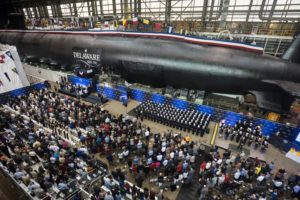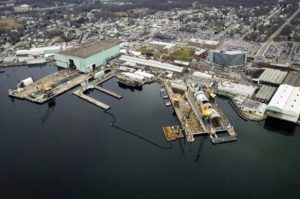The Navy’s top officer recently said he thinks the AUKUS Australia submarine agreement is helping send a clear message to the submarine shipbuilders for long-term procurement and investment.
“Informed by our visit, just a week ago, up to [Electric Boat in Groton, Conn.], I have a high degree of confidence that industry is responding. They understand that they need to hit the accelerator with respect to their production rates. And whether it’s
Newport News Shipbuilding down in Virginia, or up at Electric Boat in Connecticut, I think they both have that clear message.,” Chief of Naval Operations Adm. Michael Gilday said in response to questions from Rep. Joe Courtney (D-Conn.) during a House panel on April 28.
Gilday visited the Electric Boat facility with Courtney on April 13 where they toured shipyard facilities and met with company leadership.

During a hearing of the House Armed Services Committee, Courtney said there has been some “heartburn” that as part of the AUKUS agreement, Australia plans to acquire three to five Virginia-class submarines before ultimately moving to produce its own nuclear-powered submarines domestically, dubbed the SSN-AUKUS.
He continued that some may see that future procurement “like a detraction or diminishment in a zero sum game in terms of our own undersea fleet,” given submarine production capabilities.
The AUKUS details come months after Gilday said the shipbuilding industry needed to prove it can build ships at the rate the government seeks for domestic requirements, like two Virginia-class submarines annually. At the time he said industry was only delivering the submarines at a rate of 1.2 submarines per year (Defense Daily, Jan. 11).
However, by March, Secretary of the Navy Carlos Del Toro told the House Appropriations Committee that submarine production had somewhat improved to 1.4 boats per year.
Virginia-class submarine production is split between General Dynamics Electric Boat [GD] and HII [HII] Newport News Shipbuilding. Electric Boat builds the middle portions and reactor compartment while HII builds the bows and sterns of the submarines, then the companies take turns on final assembly.
Gilday said that the first steps of AUKUS that involved deploying U.S. and United Kingdom attack submarines to Australia “is a game changer” that aids deterrence with China.
“Deterrence is all about capability and intent. You bring it up to an exponential level when you leverage allies and partners in [the People’s Republic of China] backyard with the best capability in the world, operating in and around China. So I think there’s so much there with respect to potential, not just for the United States, but for all the nations that intend to sail and use the maritime commons around the PRC.”
Courtney underscored that Australia Defense Minister Pat Conroy has said Australia will directly invest $3 billion into the U.S. industrial base as it seeks to buy several Virginia-class submarines and build up its own nuclear-powered submarine construction capability.

“I mean, this is Australia investment into the industrial base of the United States, which is again unprecedented and certainly shows the level of commitment of that nation to this undertaking,” Courtney said.
Gilday said he sees manpower as the “biggest challenge” for both the U.S. and Australia industrial bases, but argued they are a trustworthy partner and favored congressional or executive action to better allow foreign nationals to access American shipyards as needed.
“With respect to getting the Australian experts into our shipyards, into our submarines without any restrictions, this is a fellow five-eye nation that we trust with our most sensitive intelligence and they do and they trust us with theirs. I think that we need to look at where the constraints are and I think bring those to the right level – that might be the Congress, it might be the White House, but to break those down so that we can truly make this optimal path a reality.”